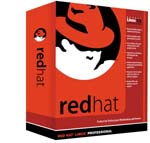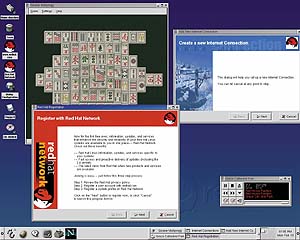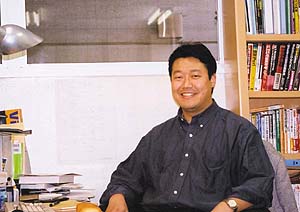
In early 2000, when the Internet bubble burst in Japan, not paying license fees for proprietary software suddenly made sense. IBM reported 30 percent growth in the number of enterprise-level applications for
GNU/Linux in the six month period ending June 2001. Open source had one foot in the corporate boardroom. Many of the Japanese open source companies I spoke to sounded as if convincing their customers about the value of open source was a battle that had largely been won.
Before probing the relationship between Japan and open source software, let's be clear about what open source actually is. Open source is the antithesis of the proprietary software model of companies like Microsoft that carefully guard the
source code (see Jargon Buster, page 35) of their products. Open source projects such as Linux make their source code available for anyone to see and allow anyone to contribute code. This means that problems and bugs can be analyzed by thousands of hackers all over the world, something beyond even a Microsoft development budget. The upshot is that open source projects can become very stable and reliable over time. A key example is the Apache Web server, the No. 1 Web server on the public Internet since April 1996.
Personal experience with open source software (OSS) suggests that projects often start out with low quality software and quickly either die out or improve. Chris Phelan, CEO of Vanten, an open source solutions provider in Tokyo's Asakusa district, says the quality bar for open source projects is often higher than for proprietary software. "OSS projects have to be higher quality in order to gain market acceptance because they don't have big marketing budgets behind them," he says. "If an open source project reaches market acceptance, people know it is because of successful installations and people supporting the code, not marketing dollars."
"There is no downside to OSS," says Nobuo Kita, president of system integrator 10art-ni (intranet spelled backwards), which works extensively with open source software. But proprietary systems from Sun Microsystems, for example, can have up to 64 CPUs, something Linux fails to robustly support at the moment. How to get around this? Well it turns out that some of Japan's largest companies are focusing on the problem.
Gen Narui, chairman of the Japan Linux Professional Institute, says that "overcoming this performance issue is one of the objectives of the Big Four Consortium and within a couple of years this last performance barrier will have been overcome."
The Big Four Consortium? In May 2001 Fujitsu, Hitachi, IBM and NEC -- the big four mainframe vendors -- announced a partnership to enhance Linux enterprise capabilities. The companies decided to implement a shared common plan to help Linux mature, working together with the Linux community to develop various open source projects. This kind of move, along with others such as Amazon switching to open source systems, Oracle moving all their internal systems to Linux, and Sun starting to provide low-end servers for Linux, have changed things considerably. "While there once might have been worries about Linux's stability, these have largely evaporated in the face of blue-chip company adoptions," Narui says.
 Merrill Lynch and other large financial organizations talked about their first
companywide Linux implementations at an event hosted by Red Hat software in March this year. Merrill Lynch chief technology officer Rick Carey has been telling all Merrill vendors that they need to have a Linux strategy. All this lends credibility to the argument that Linux can be used in place of established Unix systems.
Naturally, many open source projects do not provide the same kind of services as a proprietary software vendor. But sometimes open source software can be safer, particularly if proprietary software ends up being abandoned by the parent company. Asking customers to upgrade to the latest version of a software package and removing support for older versions is a long-standing business model that keeps consumers paying through the nose, and sometimes the change is hard to swallow. Phelan gives the example of i-chat, a software package targeted at Internet service providers (ISPs). The parent company was bought out and a year later the project was terminated. A notice on the company's Web site said it was shifting its development resources to non-chat applications, and that was that.
Merrill Lynch and other large financial organizations talked about their first
companywide Linux implementations at an event hosted by Red Hat software in March this year. Merrill Lynch chief technology officer Rick Carey has been telling all Merrill vendors that they need to have a Linux strategy. All this lends credibility to the argument that Linux can be used in place of established Unix systems.
Naturally, many open source projects do not provide the same kind of services as a proprietary software vendor. But sometimes open source software can be safer, particularly if proprietary software ends up being abandoned by the parent company. Asking customers to upgrade to the latest version of a software package and removing support for older versions is a long-standing business model that keeps consumers paying through the nose, and sometimes the change is hard to swallow. Phelan gives the example of i-chat, a software package targeted at Internet service providers (ISPs). The parent company was bought out and a year later the project was terminated. A notice on the company's Web site said it was shifting its development resources to non-chat applications, and that was that.
"The ISPs who used this product were now in the position of providing chat without vendor support for a system where they couldn't access the source code," Phelan says. "With OSS, as long as there are other companies still using the product there will be mailing lists, Web pages, patches, et cetera." It seems the key component in open source is community.
Now big business has set up shop in this open source community. "If IBM and others want to provide customer specific modifications to the enterprise servers they are providing, they have to move to Linux," Narui says. He says there are too many operating systems for hardware vendors to handle, but only two are growing: Windows and Linux. For businesses, avoiding Linux increasingly means casting all of your chips with Microsoft.
So why should you side with Linux? Many people in the open source community I spoke to used the analogy of a car. Cars basically all operate the same way. However one can vary the color scheme, body and suspension, for example. The same is true of Linux. The Linux
kernel offers a basic standard that can be used consistently, but different features can be added, just like a car can have four-wheel drive and a sun roof put in.
Jeremy Adrian, CEO of HydraNet, who works almost exclusively with OSS, put it like this:" If you're dealing with Microsoft, they deliver a more user-friendly product, but if you need changes made or you've got a bug that needs fixing, you're dependent on Microsoft to get that done. Since it's probably easier to put a man on the moon than to get Microsoft to budge, we find open source an easier path to follow."
 In Japan, TurboLinux, one of the four main worldwide Linux distributors, was the first to support a Japanese-language install process. "TurboLinux probably has more than 50 percent of the Japanese (OSS) market and more than 70 percent in China." Says Fumiko Doi, head of marketing for Turbolinux. "Throughout Asia TurboLinux is popular due to its ongoing focus on the double-byte encoding support required for non-Roman alphabets."
In Japan, TurboLinux, one of the four main worldwide Linux distributors, was the first to support a Japanese-language install process. "TurboLinux probably has more than 50 percent of the Japanese (OSS) market and more than 70 percent in China." Says Fumiko Doi, head of marketing for Turbolinux. "Throughout Asia TurboLinux is popular due to its ongoing focus on the double-byte encoding support required for non-Roman alphabets."
Doi explained that the two main components of any Linux distribution are the Linux kernel and glibc. The different distributions involve the distributor selecting a particular kernel and glibc, then bundling them with patches and drivers such that the distribution is tuned for a particular environment or performance level.
Is Turbolinux as popular in Japan as Doi suggests? "Turbolinux has advantages, such as commercial Japanese fonts," says Yoshihiko Baba, the webmaster of the Tokyo Linux Users Group (TLUG). "But their system does not seem to appeal to my friends and myself." He pointed out that in Japan, Free BSD, another Linux distributor, has a higher share than in other countries.
TurboLinux is perhaps more enterprise-focused, having strong ties with IBM, Fujitsu and NEC. The OSS system integrators (SIs) will supply a solution that may or may not contain a hardware component, a distribution and software from specific vendors, along with their own solutions and consulting, Doi explains. TurboLinux tends to provide solutions through the SI intermediaries rather then directly to individual companies, which would explain the lower support for TurboLinux among Japanese hobbyists.
TurboLinux has over 200 partners through their wryly named TurboLinks program, forming a network of SIs, hardware vendors and resellers of all kinds. Closed source proprietary software is also a part of this picture. TurboLinux is first and foremost a software distributor and provides closed source software packages such as ClusterPro, cluster management software and Power Cockpit, a remote install management system. The fact that TurboLinux provides both open and closed source software shows how the open source business model is still in development.
Doi says that for some software the open source approach does not make sense. But if you have a problem with a piece of Microsoft software, then you can only go to one place to get it fixed. "When using an open source package, you are free to find solutions from anybody who can understand the code," Doi says.
But many Japanese companies are still wary of open source systems or just not interested in changing over. "This is particularly true for SIs and value-added resellers who are very happy with the proprietary model since it has served them well," says Phelan of Vanten. "In Japan, 'if it's not broken don't fix it' makes a lot of sense to many decision makers."
That said many decision makers are starting to ask questions like "Why do I have to pay a million dollars in license fees for my database?" Phalen describes Vanten's job as showing decision-makers that the quality will not go down, and more recently, that it may actually start to go up if they switch to an open source system.
"OSS now reminds me of the ISP business in 1995," says Phelan, who worked on Japan's first ISP, Global Online. "In five years I am sure OSS will be widely deployed."
 Another important player in Japan's open source community is TuneBiz, a systems integrator that concentrates on tuning open source systems for security and performance. The TuneBiz offices are nestled away in Tsukiji, near the world's largest fish market. Ryotaro Okada, CEO and 'tuner,' points out that while average OSS quality may be good, development is fast, meaning the latest releases may be less than totally secure. "It's generally good to wait before using the latest open source releases," recommends Okada. "But sometimes business needs prevent this."
Another important player in Japan's open source community is TuneBiz, a systems integrator that concentrates on tuning open source systems for security and performance. The TuneBiz offices are nestled away in Tsukiji, near the world's largest fish market. Ryotaro Okada, CEO and 'tuner,' points out that while average OSS quality may be good, development is fast, meaning the latest releases may be less than totally secure. "It's generally good to wait before using the latest open source releases," recommends Okada. "But sometimes business needs prevent this."
TuneBiz has been running since January 2001, but Okada has been doing freelance consulting for 13 years. Employees of TuneBiz are members of many Japanese open source groups and Okada is the Linux guide on
All About Japan ( http://allabout.co.jp
). TuneBiz also involves itself heavily in advertising upcoming OSS conferences on its Web site. Last year Zend (the Israeli company behind the PHP scripting language), TuneBiz and 10art-ni teamed up to handle Zend product distribution in Japan as well as manage their Z-Pal program. Okada describes Z-Pal as limited open source. Zend's framework allows for solutions and code to be shared within their special partnership group, which you have to pay to enter, but once you're in you can benefit from the experience and the software of the other members.
TuneBiz wrote the IT security policy for the Osaka City government -- a huge system for dealing with water works, construction and transportation that is second only to Tokyo itself. The entire thing was built using TuneBiz templates in under three months, taking advantage of what is called an 'internally open' system. This means that the code internal to the project could be accessed and customized by the IT people within the Osaka City government. TuneBiz provided the template pattern for Osaka, recommended software and explained how to operate the system, but let the Osaka IT people actually handle the business of implementing the system.
Okada says that while Western companies might start using a new thing at the drop of a hat, Japanese companies are much more likely to ask, "Who else is using this?" The TuneBiz CEO onfides that within a select group of SIs such as SRA, Vanten, TuneBiz, NTTcomware and NECSoft group, there is a secret network of information-sharing on subjects like research and development. They talk with each other about new technologies, but they don't make this information available to other companies.
10art-ni is larger than both TuneBiz and Vanten, and less focused on open source. But president Kita says the company recently finished a merger with Northern Light, a Linux oriented hardware supplier. The merger had brought them up to 115 employees and given them a broad enterprise solutions focus encompassing the Java/OSS skills of the original 10art-ni and new hardware expertise from Northern Light.
10art-ni's focus is supplying companies with solutions such as enterprise resource planning, customer relations management and supply chain management. These individual components are not themselves open source, but they are built on top of an open source middleware layer, such as Linux, and open-source databases. Kita boasts that the company is the largest open source solutions provider in Japan, but one could get into arguments about how to measure that, and what qualifies someone as an open source solutions provider. 10art-ni's revenue is approximately 30 percent hardware, 30 percent Linux-based solutions and 40 percent Java/Web applications, according to Kita.
Kita says the open source community is active in Japan but there aren't as many developers or innovators as you may find elsewhere. "There are many engineers in Japan, but perhaps they lack talent, or maybe it's more an issue of personality and character," he says. This was a message I heard repeatedly from open source software developers.
It seems even Japanese open source developers don't see a good match between OSS and Japan. Hidekazu Umeda, previously of Gram Design, is one open source developer who has started his own venture company. Skyley Networks is focusing on decentralized wireless systems and has impressive demos of ad-hoc networks formed over groups of Bluetooth-enabled PDAs. The Decentra software makes use of the open source Japanese Peer to Peer Protocol (JPPP). "Even if other companies can out-compete us in terms of resources, we can achieve widespread adoption through the open source framework," he says.
Umeda mentions a number of other Japanese open source projects such as Java-based XML parser baykit and Java-based distributed object library Horb as a sign that the open source community is alive and well in Japan.
Narui is chairman of the nonprofit Linux Professional Institute Japan, the Japan branch of a worldwide group that certifies Linux engineers. It is supported by all four of Japan's big hardware vendors, making it the defacto standard. Narui says that while the global server market is maybe 25 percent Linux, in two or three years, this will balloon to 50 percent, creating an even greater need for Linux engineers, especially in Japan. "However, Japan does not have enough young people and China is well poised to take advantage of this," he warns.
Still Narui says the demand for Linux engineers in Japan is set to boom. He offers five reasons for the boom. First, three of the big four mainframe makers are Japanese and they've adopted Linux. That means not only engineers to support Linux servers but also engineers to port all the different applications. Narui suggests that this could make the market for Linux Engineers in Japan even bigger than in the US.
Second, Narui points to the video game market. Sony announced this January that independent developers could access the Linux environment on Playstation 2 in order to create their own games.
Third, Narui points to the thriving robotic community here. A majority of the Robocup (robotic soccer tournament) robots are Linux based. (Coincidentally, Japan is the source for the world's first open source robot, Pino, featured in our February 2002 issue). Roboticists are often academics who use Linux because they want people to be free to build anything on top of their architecture.
Narui also says there are now embedded devices for Linux. Recently, Sharp began using Linux in its American version of the latest Zaurus PDA. Finally, Narui says the medical community is starting to use a new system for medical data exchange. This system will be Linux-based and nationwide, meaning that not only large university hospitals but also small doctors' offices are going to require Linux IT support from local companies all over Japan.
It seems that by the very nature of open source, high quality free versions of any piece of software could eventually become available, crushing existing business models along the way. Does this mean that every OSS business is destined to go to the wall once public demand for free software is sated? Much depends on how conventional software manufacturers react to the challenge, but it seems OSS vendors will have to evolve their business models faster and faster to keep themselves on the cutting edge. @
|



 Merrill Lynch and other large financial organizations talked about their first
companywide Linux implementations at an event hosted by Red Hat software in March this year. Merrill Lynch chief technology officer Rick Carey has been telling all Merrill vendors that they need to have a Linux strategy. All this lends credibility to the argument that Linux can be used in place of established Unix systems.
Naturally, many open source projects do not provide the same kind of services as a proprietary software vendor. But sometimes open source software can be safer, particularly if proprietary software ends up being abandoned by the parent company. Asking customers to upgrade to the latest version of a software package and removing support for older versions is a long-standing business model that keeps consumers paying through the nose, and sometimes the change is hard to swallow. Phelan gives the example of i-chat, a software package targeted at Internet service providers (ISPs). The parent company was bought out and a year later the project was terminated. A notice on the company's Web site said it was shifting its development resources to non-chat applications, and that was that.
Merrill Lynch and other large financial organizations talked about their first
companywide Linux implementations at an event hosted by Red Hat software in March this year. Merrill Lynch chief technology officer Rick Carey has been telling all Merrill vendors that they need to have a Linux strategy. All this lends credibility to the argument that Linux can be used in place of established Unix systems.
Naturally, many open source projects do not provide the same kind of services as a proprietary software vendor. But sometimes open source software can be safer, particularly if proprietary software ends up being abandoned by the parent company. Asking customers to upgrade to the latest version of a software package and removing support for older versions is a long-standing business model that keeps consumers paying through the nose, and sometimes the change is hard to swallow. Phelan gives the example of i-chat, a software package targeted at Internet service providers (ISPs). The parent company was bought out and a year later the project was terminated. A notice on the company's Web site said it was shifting its development resources to non-chat applications, and that was that.  In Japan, TurboLinux, one of the four main worldwide Linux distributors, was the first to support a Japanese-language install process. "TurboLinux probably has more than 50 percent of the Japanese (OSS) market and more than 70 percent in China." Says Fumiko Doi, head of marketing for Turbolinux. "Throughout Asia TurboLinux is popular due to its ongoing focus on the double-byte encoding support required for non-Roman alphabets."
In Japan, TurboLinux, one of the four main worldwide Linux distributors, was the first to support a Japanese-language install process. "TurboLinux probably has more than 50 percent of the Japanese (OSS) market and more than 70 percent in China." Says Fumiko Doi, head of marketing for Turbolinux. "Throughout Asia TurboLinux is popular due to its ongoing focus on the double-byte encoding support required for non-Roman alphabets." Another important player in Japan's open source community is TuneBiz, a systems integrator that concentrates on tuning open source systems for security and performance. The TuneBiz offices are nestled away in Tsukiji, near the world's largest fish market. Ryotaro Okada, CEO and 'tuner,' points out that while average OSS quality may be good, development is fast, meaning the latest releases may be less than totally secure. "It's generally good to wait before using the latest open source releases," recommends Okada. "But sometimes business needs prevent this."
Another important player in Japan's open source community is TuneBiz, a systems integrator that concentrates on tuning open source systems for security and performance. The TuneBiz offices are nestled away in Tsukiji, near the world's largest fish market. Ryotaro Okada, CEO and 'tuner,' points out that while average OSS quality may be good, development is fast, meaning the latest releases may be less than totally secure. "It's generally good to wait before using the latest open source releases," recommends Okada. "But sometimes business needs prevent this."


